My earliest memories of Khejri trees are from the driving trips made to Shekhawati in Rajasthan during my childhood years. Khejri trees were ubiquitous after a drive of 70 Km from Jaipur. The semi-arid landscape of Rajasthan on either side of a single-lane road was dominated by Khejri. Often, the Khejri trees were in a pruned state just like in the below picture. Akada shrubs, Neem, and Khejri trees were all one could see for miles.
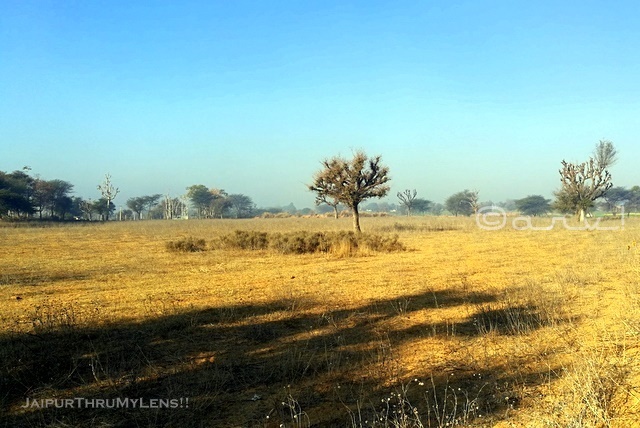
Khejri Tree | The Complete Guide
The Khejri tree is not well known even in Rajasthan because it is found in a specific area of the state. I’m not sure if people outside Rajasthan have heard about the Khejri tree. This blog intends to provide all the information a layman needs about the state tree of Rajasthan.
As a stamp collector in my teenage years, I secured a stamp issued by India Post featuring the Khejri tree. Here is a picture of the stamp with Khejri.
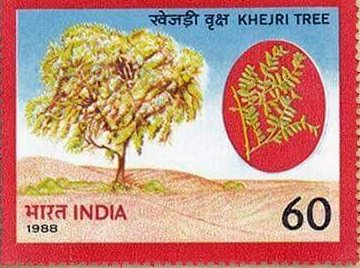
Other Names of Khejri Tree
The scientific name of the Khejri tree is Prosopis Cineraria. In India, it is also known by many other names such as Shami, Khijro, Jand, Jhand, Jat, Khar, Kanda, and Jammi depending on the region. In Rajasthan, it is called Khejri or Khejro. It is called Ghaf in the Middle East region.
Where Can One Find Khejri Tree?
Khejri is the most dominant tree in western Rajasthan; and for this exact reason, Khejri is called the state tree of Rajasthan. It was declared a state tree in the year 1982-83. The tree is also present in the Middle East region and is called Ghaf Tree. One can also find the Khejri Tree in some parts of Haryana bordering Rajasthan having similar ecological conditions.
The tree is not easy to spot in cities like Jaipur due to rapid urbanization. The Forest Department has preferred decorative and flowering trees like Gulmohar and Golden Shower Cassia trees over native species. One can surely find the Khejri tree in the suburbs and villages near Jaipur.
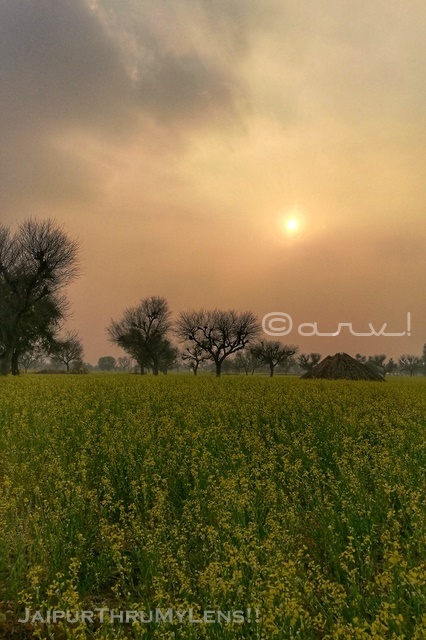
Connection OF Khejri Tree with Jaipur & Ram Bhagwan
The Khejri tree is associated with Jaipur and its history. During pre-independence, the king of Jaipur would worship the Khejri tree on the day of Dussehra. The rulers of Jaipur were Kacchawa Rajputs, the descendants of Ram Bhagwan. It is believed that Lord Ram worshipped a Khejri tree before the final battle with the King of Lanka, Ravana. In this battle, Ram Bhagwan killed Ravana. Dussehra is one of the festivals that predates Diwali and is a celebration of this win by Bhagwan Ram. The tradition of worshipping the Khejri tree in the Jaipur royal family nevertheless continues in a modified and scaled-down manner.
Fruit & Leaves
Its leaves resemble Gulmohar leaves and are similar to the ones found in other trees of the same family like Babool, Sickle bush tree, Prosopis Juliflora, or Vilayti Babool. All these belong to the Fabaceae family. Here are a few pictures of leaves from this family.
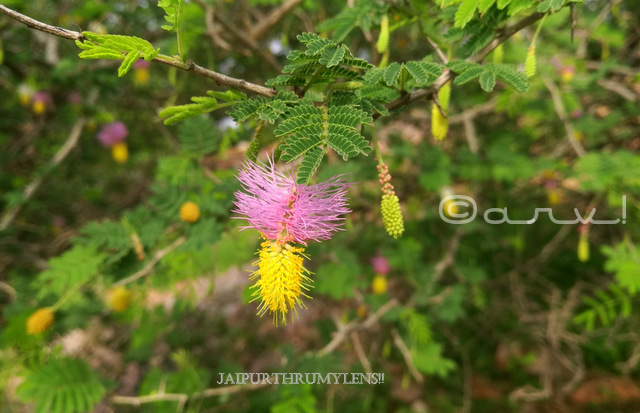
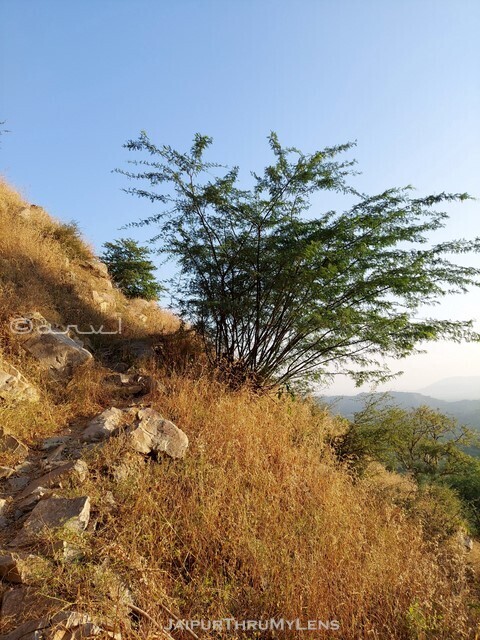
The spikes in Khejri are very small and appear as a single unit. It sheds its leaves in January and new ones appear in February-March. The fruit appears between May and July in the shape of a slender stalked pod measuring between 7-20 cm. Initially, it is green in color and later turns into a brownish shade.
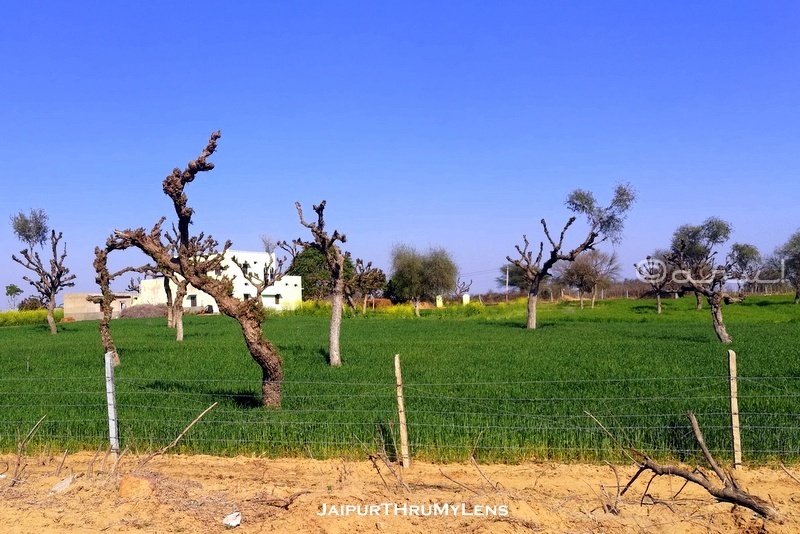
Khejri Tree Uses
It is logical to ask what is the use of the Khejri tree? The Khejri tree used to play a vital role in the economy of villages and rural areas.
- The leaves are used as fodder for cattle and therefore one observes the tree in a pruned state. A single tree provides approximately 60 kg of fodder for cattle annually. The pruning is also done to enhance tree growth at the start of the winter season.
- Apart from this, leaves also make for excellent compost.
- The wood from the tree is used for preparing food as firewood.
- Some documents suggest that the bark of Khejri was used as flour during the Famine of Rajputana in 1869. Even today the bark is used in treating many skin conditions like leprosy, boils, and itching. It is used in treating asthma in Ayurveda.
- The flowers of this tree are consumed by pregnant women along with sugar.
- The farmers are happy to have this tree in the field because its root enriches the soil, thereby helping increase the crop yield.
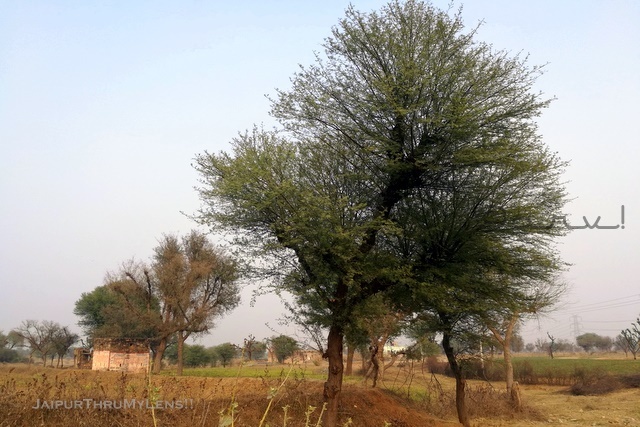
Sangri
The texture of the bark of the Kheri tree is quite similar to the one in the Neem tree – rough and cracked. The dried fruit of the tree is used as Sangri. People who appreciate Rajasthani food must have heard of Ker Sangri. While Ker grows on a bush, Sangri is derived from the Khejri tree. It fruits in summer. Sangri is a pendulous bean-like pod. These pods are used as fodder.
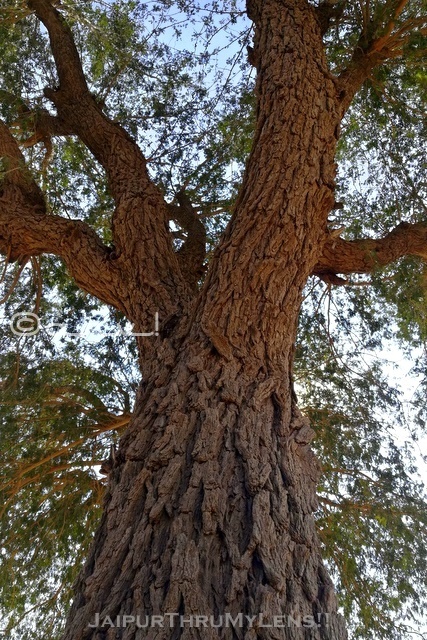
Benefits
The Khejri tree is a hardy tree that requires less care which explains why it can be easily sighted in the Thar desert. It can survive in cold & severe hot conditions with a temperature range of 5-47 C. The tree is well known for its ability to bind the soil. Its roots can attain a considerable depth in search of water sources. The Khejri tree is found in areas that receive an annual rainfall of less than 75-80 cm. This is one of the secrets to its survival in the hot and harsh climate. As per a report by the Central Arid Zone Research Institute in 2015, the Khejri tree is gradually losing ground. The area covered by this tree has come down significantly. It is said that in the past, this tree was found in Punjab. But with increased water availability, the scenario has changed. It is unlikely to be found where the annual rainfall exceeds 100 cm. Many reasons are being provided against this phenomenon but these are just theories. We still don’t know the exact cause. It wouldn’t be incorrect to say that changes in the lifestyle of the rural areas from agrarian to modern are one of the major causes. New sources of water and the availability of modern fertilizers have brought in changes bound to impact old ways. Even then, a significant landscape in Rajasthan is covered by the Khejri tree. The tree takes a long time to grow and unless we plant a lot more trees now it is unlikely the situation will change. Central Arid Zone Research Institute (CAZRI) in Jodhpur is involved in doing research on the Khejri tree.
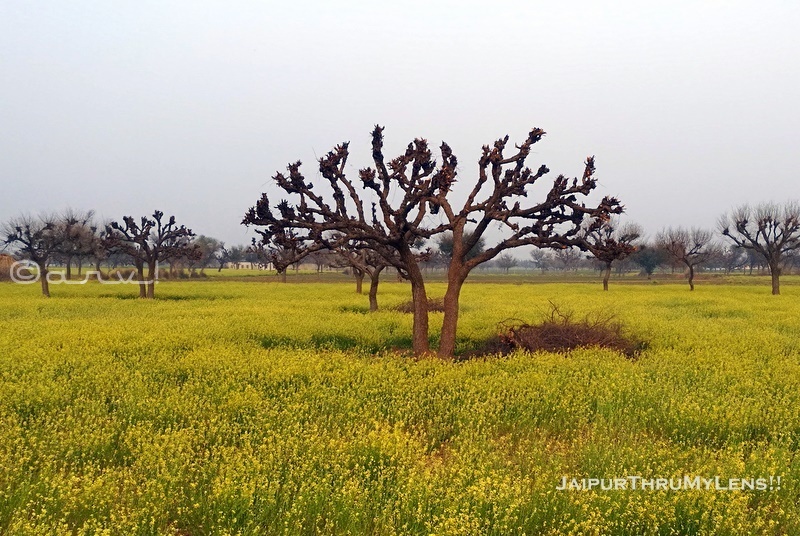
Check out other stories in the Trees of Jaipur.
Stay updated via Facebook, Twitter, Instagram
Threats & reasons for the falling population of Khejri tree
Unfortunately, the state forest department hasn’t been a catalyst in promoting this tree. We have seen the ill effects of the flawed policies adopted by the Forest Dept. during the last few years by promoting imported trees like Israeli Babool and Australian Eucalyptus. Both these trees have been counterproductive leading to more harm than gain. In the case of the latter, the soil underneath would turn infertile. Local trees support the local ecology but imported trees don’t. Khejri tree is linked with many historical events like the Chipko Movement started by Sunderlal Bahuguna in the 1970s. It is stated that this movement itself was fuelled by an event that took place in the early 1700s in Jodhpur. A king ordered the cutting of Khejri trees; the local Bishnoi community opposed the movement to retain them from felling. More details are further in this post about this event.
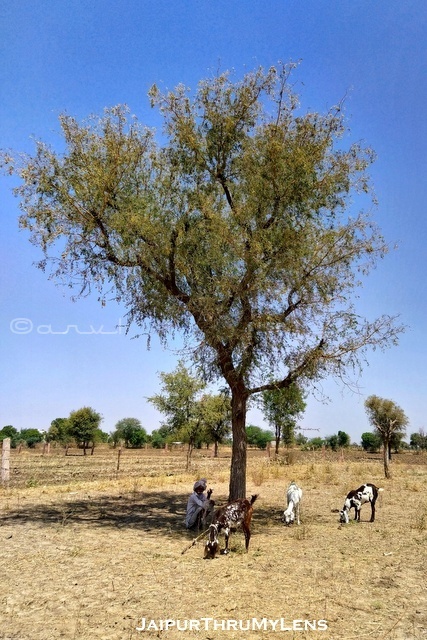
During the Chipko movement or Chipko Aandolan, people in Uttarakhand started hugging trees to stop woodcutters from cutting trees. Unfortunately, despite declaring Khejri as the state tree of Rajasthan, the government hasn’t done anything. The government did not declare cutting this tree a punishable offense nor plan for the planting of Khejri trees. During the famine of 1899, many people survived by eating the bark of this tree.
Khejarli Village Massacre and Amrita Devi Bishnoi
This event is one of the least known historical events of Rajasthan. In September 1730, in the village of Khejarli near Jodhpur, a woman along with her three daughters gave up their lives trying to save Khejri trees from felling. The woman was Amrita Devi Bishnoi from the Bishnoi community who considered Khejri as a sacred tree. The information available is the ruler of Jodhpur, Abhay Singh wanted wood from Khejri trees. Amrita Devi Bishnoi protested the felling of the trees. Along with her, other Bishnoi community members also joined in trying to protect the trees. In total, 363 people from this community were killed. This Khejadli village story of Amrita Devi Bishnoi is not known to many people. It was the first known Khejri tree movement and probably the first-ever Chipko movement in India. Today, most of us have only heard of the Chipko Movement led by Sunderlal Bahuguna in the 1970s. There is a need to inform people Khejarli Movement by Amrita Devi Bishnoi.
We need native trees like Neem, Peepal, and Dhok to name a few to preserve local ecology. What’s your view? Have you ever seen the Kheri tree? Or ever tried Ker Sangri in Jaipur or elsewhere in Rajasthan?
Read complete posts on trees found in Jaipur – Trees of Jaipur
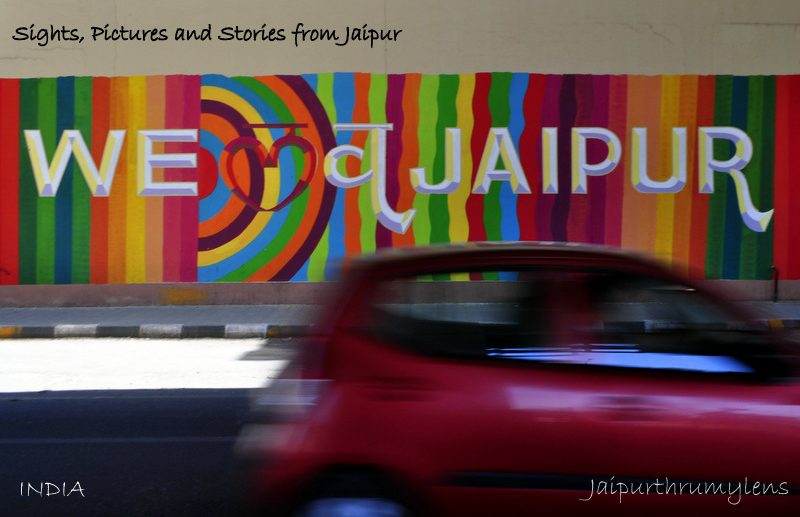

Khejri is our heritage in many ways… It supported us from many years… Now it is our turn to protect it..
LikeLiked by 2 people
Absolutely. But I guess we are losing the connect with modern lifestyle. We are less reliant on many things the tree offers. The cattle is being fed with commercial cattle feed as an example. Have you ever seen this tree?
LikeLiked by 1 person
No arv… But I read everything you written… I am now more curious about khejri..
LikeLiked by 2 people
I’m glad I piqued your interest. Which city do you call it a home, Ketki?
LikeLiked by 1 person
Pune, MH
LikeLiked by 2 people
Lovely city with beautiful weather! 🙂
LikeLiked by 1 person
U been here??
LikeLiked by 2 people
That was many years ago. 🙂
LikeLiked by 1 person
Now it has changed drastically
LikeLiked by 2 people
I’m sure it must have. For good or bad?
LikeLiked by 1 person
Wherever we live we certainly need local trees. Over the centuries they and the rest of the local ecology adapt to work with each other until today they are an essential part of that ecology.
LikeLiked by 2 people
I agree. Nature ensured that trees support local ecology and are hardy enough to survive in local climatic conditions. This is a reason why we don’t have oak and spruce in semi-arid region. Similarly, trees like Neem and Khejri will never survive English cold. I think it is best if our race stopped playing around with nature. We haven’t yet reached a point where we can rule nature completely. We are witnessing the ill-effects of tampering, already. Some people on the contary feels that these extreme climatic situation are part of planet’s evolution. We won’t know what is true, though. I know for sure you are a person who loves woods. Which is your favorite tree?
LikeLiked by 2 people
Favourite? That’s a difficult one. I’ve always had a soft spot for the English Oak, although there are so many others I love, too. It depends on where I am – in India I’m particularly fond of the Neem and the Flame Tree.
LikeLiked by 2 people
I was thinking about Oak when I asked. I guess that’s a popular tree for making furniture. Flame of the forest is certainly beautiful. Have you ever heard of silk cotton tree? Quite similar to the flowers of flame of the forest tree
LikeLiked by 2 people
I haven’t, Arv. I had to look it up. Yes, the flowers look very similar, don’t they?
LikeLiked by 2 people
I think you must have. They flower during spring and I assume you must have seen plenty of them in Bihar if you were there in this season. Flame of the forest is orange in color while other is crimson.
LikeLiked by 2 people
I do agree we have been exploiting the nature for our comforts…greed instead of co-existing harmoniously . Our future generation would suffer. They would have to pay the price for it.
LikeLiked by 2 people
You are right. Our race is the most ferocious species on this planet. We want all resources exclusively for us. A reason for extinction of many animals and plants. Looks like you are a nature lover?
LikeLiked by 2 people
Yes, I love being around nature.
LikeLiked by 2 people
Great. Where are you based?
LikeLiked by 2 people
Far away in the hills of Himalayas …..Arunachal Pradesh…one f the top three greenest states in our country
LikeLiked by 2 people
ah! cool! May be I will visit someday! 🙂
LikeLiked by 2 people
You should
LikeLiked by 2 people
I’m hoping to 🙂
LikeLiked by 2 people
👍
LikeLiked by 2 people
I never grow tired of reading your posts and viewing your gorgeous images, Arv. This was a very interesting article on the state tree of your region. Thank you!
LikeLiked by 2 people
I’m glad you liked this post. Which trees are commonly found in your province?
LikeLiked by 2 people
Too numerous to list them all, but here are few: cedar, fir, spcuce, hemlock, larch, birch, maple, oak and many more.
LikeLiked by 2 people
I guess maple and oak are the most sought after in terms of uses.
LikeLiked by 2 people
One tree that comes with a big legacy. Interesting to note it’s association with Chipjo movement. I hope the authorities promote it as losing indigenous natural heritage wouldn’t do good to anyone. Amazed by your detailing of a single type of tree.
LikeLiked by 2 people
Let’s hope so, Nellanjana. We need to appreciate what is around us rather than fancy what we don’t have. If you are curious, finding information is not very difficult. Do you love trees?
LikeLiked by 2 people
True that. We never value what we have and that’s true in every aspect of life. I absolutely love trees…have you read this book – The Hidden Life of Trees? If you haven’t, do try and grab one.
LikeLiked by 2 people
No, I haven’t. I looked it up and this sounds interesting. Will get a copy. Thanks for sharing this information. 🙂
LikeLiked by 2 people
Shami tree is a sacred tree. Another name for Lord Shiva & people keep one at the entrance of the house (or west side) for certain vastu purpose. It is believed that if you keep a few leaves of Shami / Khejri with you,the day unfolds brilliantly .But if you have one at home you need to treat it like a God (represents Shani dev) …….
A good read Arvind. I know a bit about Shami but was not aware it’s Khejri 😊
LikeLiked by 2 people
Monica! that’s something I was not aware of. Good to know. In fact, I have never heard that this tree was called Shami. I have always known it by Khejri. The case as your 🙂
How do you know so much about the religious connection of this tree?
LikeLiked by 1 person
I have an ardent Shiv bhakt at home and a friend has this plant at home. Apparently, the plant is got home with pomp & show like one would get an idol during puja. I also got to know that Rajasthan shares same tree as state tree of Telangana.
LikeLiked by 1 person
oh! wow! That’s interesting. Are you religious too? Yes, this is also a state tree of Telangana, although they call it by another name. 🙂
LikeLiked by 1 person
Spiritual in fact ….. Personally, I am not into rituals etc. If I “need” to be there and participate in one as a better half, I would.
LikeLiked by 2 people
cool. Unfortunately, people think spirituality and religion are one and the same thing.
LikeLiked by 3 people
Yes!
LikeLiked by 2 people
Arv, I never knew the local name of this tree to be Khejri, nor did I try to find out but used to call it as some species of Babool. I have seen them in many places and probably a couple of them in my vicinity (just need to cross-check if they are not Babool). Although I feel every native vegetation is important and has its role to play I never had any proper idea about the significance of Khejri trees, just thought them to be the fodder for the cattle. Thanks for sharing this information.
LikeLiked by 2 people
Sarmistha, it is only recently that I have become more aware of the trees around us. I felt we don’t pay enough attention to our surroundings. There is so much to know. Often, we are curious when we travel as our minds are switched off and relaxed but it is not the case when we are back home. I know you are a nature lover and would enjoy reading more about it. Thanks for sharing your thoughts, Sarmistha. 🙂
LikeLiked by 2 people
I love trees. They do so much to benefit earth and humans. I love the history behind this tree. Great post, Arv, and as always awesome pics! 🙂
LikeLiked by 2 people
Thanks, Lisa. Yes, trees are essential for human survival as well as life on this planet. I’m glad you liked this post. Do you ever stop and notice the trees around you? the species?
LikeLiked by 2 people
I do. We live on a wooded lot and have quite a few pines, oaks, and Japanese Maple trees. 🙂
LikeLiked by 2 people
You lucky, Lisa 🙂
LikeLiked by 2 people
Thanks, Arv. I do enjoy the wild life that’s for sure! 🙂
LikeLiked by 2 people
cool! 🙂
LikeLiked by 2 people
Your photos capture the beauty of Jaipur. They
Are beautiful and exotic!
LikeLiked by 2 people
Thanks, Kim. Ever been to India?
LikeLiked by 1 person
Had always seen these trees in Rajasthan but thanks to your post I am now educated about them! WOW! There is so much to this tree from Ayurveda to chipko movement to its beautiful flowers! 🙂 Have had the Ker Sangri vegetable in Jaisalmer. Delicious!
LikeLiked by 2 people
Divyakshi, isn’t it an irony that we know so little about the trees around us? How many of us can recognize the native trees? I’m sure we all can make a difference in this world with some tree education. That’s the idea behind writing about these trees. Have you read my previous posts on trees?
LikeLiked by 1 person
Wow! what a great read. Mahro Rajasthan💛🌿
LikeLiked by 2 people
I’m glad you liked this post, Krishna. Are you from Rajasthan? Where are you baseD? You have a great blog. Just subscribed. 🙂
LikeLiked by 1 person
Interesting!
That is a hardy 🌲!
LikeLiked by 2 people
🙂
LikeLiked by 1 person
I remember seeing this tree on our road trip to Rajasthan. I will look up my archives and share the picture. What I loved about your post, Arvind was the wealth of information you shared. So good to know more about the tree. Also, looking at the leaves and the name you shared – my Mum has a Shami planted back home. She tell me at the entrance, this wards of evil.
Thanks a ton! I hope to see you back on the 12th.
LikeLiked by 2 people
I will look forward to seeing the picture from your travel. I always feel that what we post needs to be more valuable and make a difference. This is what I shared with you when we interacted on TTL. This is a reason why I decided not to share just the picture. A picture cannot do justice to beautiful trees around us. I will request everyone participating in TTL to provide the name of the trees. It’s daunting task but certainly worth the efforts. I will join whenever I have something worth sharing from this part of the world, Parul.
LikeLiked by 2 people
What an informative post! Thanks Arv!
LikeLiked by 2 people
😊
LikeLiked by 2 people
I have seen this tree being planted in Gurgaon in several places where re-greening is being done. Love the purple and yellow flowers which reminded me of the bottle brush tree. Thanks for sharing such wonderful information about this tree.
You are right about the ill will of our forest departments in ruining the tree variety in our cities and forests. We need to make sure we are planting more of the native variety as they are hardy and adjust well to the soil and water component of the region.
LikeLiked by 2 people
Khejri tree in Delhi NCR? That’s something new for me. I’m not sure about the flower part especially the purple one. I wonder why our forest department decided to follow the British legacy of planting decorative trees? A disaster actually for the local ecosystem. Are you a tree lover?
LikeLiked by 1 person
Loved it.
LikeLiked by 2 people
Happy to hear this, Sumit.
LikeLiked by 1 person
It’s always interesting reading about flora and fauna in India, Arv. You not only know the history of Jaipur well, but also the nature aspect of it as well. Never heard of the Khejeri tress and nice to read about it. It is interesting to hear it is known by different names – not something you hear about each day as you think, one plant, one name. Perhaps the tree differs slightly in different states? The photo of the yellow fruit and spokes reminds me of the bottlebrush, which is an Australian plant/tree.
I’ve heard tree sap is medicinal, and interesting to hear Khejeri tree’s bark is used for treating conditions. Nature is powerful.
Stay safe, Arv.
LikeLiked by 1 person
It is Certainly interesting to hear and know more about the trees. After all we depend on them. Even locals have seen this tree often but don’t know it’s name. Tree doesn’t figure high on the list of people. Yes, there are always many variants of every tree. Happy to hear about bottle brush. I have seen this in Singapore, if I’m not wrong. Hope things are ok in your city as far as corona is concerned.
LikeLike
One of the best things I like about trees is the shade the bigger ones provide – like your best friends on a hot sunny day. Things are not too bad here in Melbourne. Just very quiet and everyone is staying indoors.
LikeLiked by 1 person
I agree. Even here it is very sunny and trees provide respite from the heat. Good to know things are good in Melbourne. I thought you were in Sydney.
LikeLiked by 1 person
Fabulous rich history and great images.
LikeLiked by 1 person
Thanks, Justine 🙂
LikeLike
Great history depiction.
LikeLike
Thanks. Have you ever witnessed this tree?
LikeLiked by 1 person
Yes, Since the day I am in Rajasthan. I witnessed many.
LikeLiked by 1 person
Great. Where are you based in Rajasthan?
LikeLiked by 1 person
I am based in Jaipur.
LikeLiked by 1 person
Great. Happy to hear that we live in the same city.
LikeLiked by 1 person
That’s great. You too lives in Jaipur.
LikeLiked by 1 person
😊
LikeLike
A hardy and enduring tree with so much history attached to it and meaning so much to Rajasthan, should certainly be protected, in my opinion. I enjoyed reading about this tree and the part it has played in your heritage. It’s a pity that native species have come to mean so little in many places. Easier managed species, often not native ones, seem to be creeping in everywhere.
LikeLiked by 1 person
Millie, this tree is quite hardy. I guess our dependence on trees has gone down as we are increasingly becoming modern in our apporach. Also, a lot more focus is being laid to the decorative element. In India, the forest authorities asopted a wrong approach of planting trees from Australia and Africa a couple of decades ago. In the end, these trees turned out to detrimental to local ecology. Also, they do not support local fauna. I hope things are corrected fast and we adopt focus on indigenous trees. Do you notice trees around you?
LikeLike